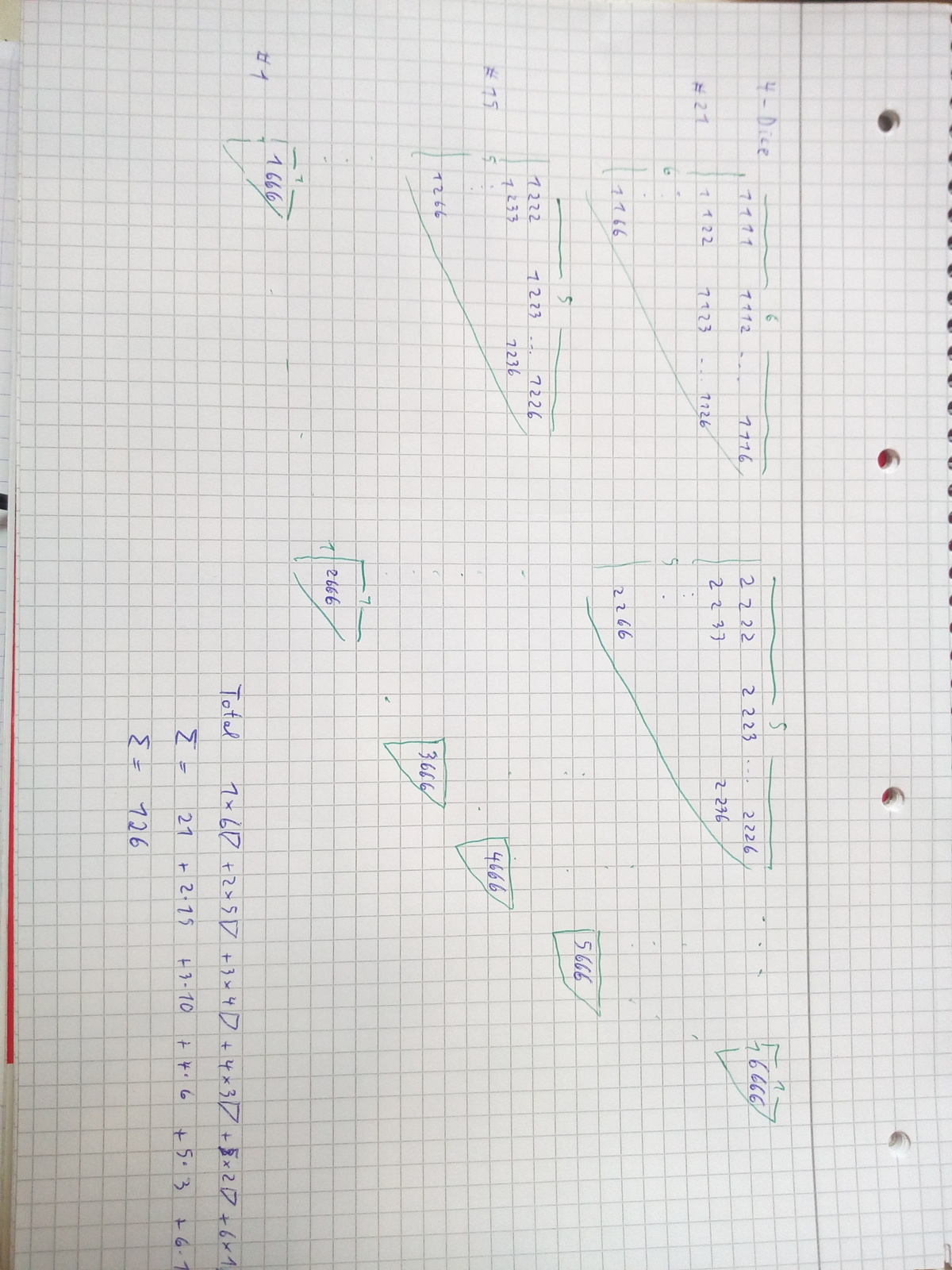A probability problem by Shiv Kumar
I throw 5 standard, 6-sided, fair dice at the same time.
What is the probability that the total five dice can be 25?
This section requires Javascript.
You are seeing this because something didn't load right. We suggest you, (a) try
refreshing the page, (b) enabling javascript if it is disabled on your browser and,
finally, (c)
loading the
non-javascript version of this page
. We're sorry about the hassle.
4 solutions


I am having Trouble calculating the number of possibilities to get with five dice, without keeping track of repetitions ( e.g. 1,5,5,5,5 = 5,1,5,5,5 is the same as I understand it) In My drawings I get up to 4 dice and get a total of 126 different combinations. But is there a pattern to get up to 5 Dice ? I assume one could visualize it as a Pyramid pointing up at the Length 6 triangle. but if for example I take the last triangle with the 6666 and I put a one in front for the 5th dice, then it would be the same as the bottom triangle 1666 plus a 6 so there are some that cancel. How to calculate this ?
Count all the ways that sum to 25.
zero 'six': 5,5,5,5,5 = 5C5 = 1
one 'six': 6,5,5,5,4 = 5C1 * 4 = 20
(5,5,5,4), (5,5,4,5), (5,4,5,5), (4,5,5,5)
two 'six': 6,6,5,5,3 = 5C2 * 6 = 10*6 = 60
(5,5,3), (5,3,5), (3,5,5), (4,4,5), (4,5,4), (5,4,4)
three 'six': 6,6,6,5,2 = 5C3 * 4 = 10*4 = 40
(5,2), (4,3), (3,4), (2,5)
four 'six': 6,6,6,6,1 = 5C4 * 1 = 5
(1)
P(X=25) = (1 + 20 + 60 + 40 + 5) / 6^5 = 126 / 6^5 = 7 / 432
would you be able to please explain in words what you did here? I don't understand why you are using the combinations you are using and why they are being multiplied by another number.
Log in to reply
If the five dice where only numbered (1-5), then there's only 1 way to achieve sum=25, that is (5,5,5,5,5). Therefore, we're not interested in any lower combination.
Now, if we add 'one six', for example: (6,5,5,5,5) = 26. Then, we need to re-balance, by substracting one: (6,4,5,5,5) = 25. How many places can we put the six? That would be 5 choose 1 = 5C1 Then, how many ways can we substract 1 from the rest (5,5,5,5)? That's 4 ways: (5,5,5,4), (5,5,4,5), (5,4,5,5), (4,5,5,5) Therefore, with 'one six', there are 5C1 * 4 ways to sum 25. 5C1 * 4C1 = 5*4 = 20 ways
What if we add 'two six'? For example (6,6,5,5,5) = 27 We need to re-balance, by substracting two: (6,6,4,4,5) = 25 How many places can we put 'two sixes'? 5C2 = 10 Then, how many ways can we substract 2 from the rest (5,5,5)? That's 6 ways: (5,5,3), (5,3,5), (3,5,5), (4,4,5), (4,5,4), (5,4,4) Therefore, with 'two six', there are 5C2 * 6 ways to sum 25. 10 * 6 = 60 ways
Summing these combinations that sum 25, divided by all the possibilites: P(X=25) = (1 + 20 + 60 + 40 + 5) / 6^5 = 126 / 6^5 = 7 / 432
We have to write 25 as a combination of 6a+5b+4c+3d+2e+1f, where a,b,c,d,e,f are non negative integers 25 = 4(6) + 1, there are 5 arangements, 25 = 3(6) + 5 + 2, there are 5!/3! = 20 arangements, 25 = 3(6) + 4 + 3, there are 5!/3! = 20 arangements, 25 = 2(6) + 2(5) + 3, there are 5!/(2! .2!) = 30 arangements, 25 = 2(6) + (5) + 2(4), there are 5!/(2! .2!) = 30 arangements, 25 = 6 + 3(5) + 4, there are 5!/3! = 20 arangements, 25 = 5(5) , there are 1 arangement, Total there are 126 arangements. The probability 126/6^5 = 7/432
how are you getting the number of arrangements? I especially don't understand the 2 sets of 30 arrangements. Can you explain in words? please
First, it's obvious that P(sum=25) = P(sum=10). Proof: Consider 25(sum of dices) as 35-10, 6(number of dice) as 7-1, 5 as 7-2, 4 as 7-3, 3 as 7-4, 2 as 7-5 and 1 as 7-6. To achieve sum 25, we can minus 10 from 35, such as 25=6+6+5+5+3 is as same as 35-10=(7-1)+(7-1)+(7-2)+(7-2)+(7-4). Actually if we choose other such as 25=30-5, we can calculate the answer, but it's a little bit more complex.
Hence, we are finding the probability of sum is 10 by 5 dices. It is equal to (Ways of sum=10 by 5 fair dices) /6^5. The required ways is same as separate 10 balls into 5 regions. But each regions must at least has one ball, because a dice cannot show number 0.Hence it's as same as separate 10-5=5 balls into 5 regions, but a region can have no ball. To create 5 regions, we need four stick.
Example : |••|•||•• means 5=0+2+1+0+2( | represent stick, • represent ball) , •|•|•||•• means 5=1+1+1+0+2, ••••||||• means 5=4+0+0+0+1.
Hence, it's obvious that the ways is (5+4)!÷5!÷4! = 9C4. Ans: 9C4/6^5=7/432